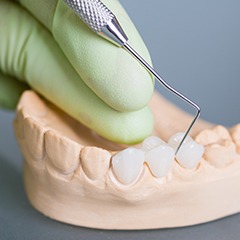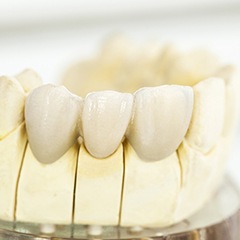Dental Bridges – Sunnyvale, TX
Say Goodbye To Gaps
Adult tooth loss is an all too common problem. Unexpected dental injury, decay, and disease can all take a toll on your dental health and leave you with the challenge of finding a suitable tooth replacement method. If you suffer from tooth loss, you need a fast, permanent, and practical solution. Dr. Philip now offers quality tooth restorations with durable dental bridgework. Ignoring a tooth loss problem is not a healthy option. The gaps left by missing teeth can cause your remaining healthy teeth to rotate or shift out of position, resulting in bite misalignment. The imbalance caused by missing teeth can also lead to decay, gum disease, and temporomandibular joint (TMJ) disorders. Don’t let your tooth loss problem wreck your oral health.
What Are Dental Bridges?

Dental bridges are used to permanently replace missing teeth with artificial teeth. Dental bridges actually "bridge" the gap left by a missing tooth. Bridges are attached to the remaining teeth for support. Unlike dentures, a fixed dental bridge can only be removed by a dentist.
How Are Dental Bridges Placed?

Before your new dental bridge can be made, the anchoring teeth must be reduced in size so that they can be fitted with dental crowns. After reduction, Dr. Philip will take impressions to provide an exact mold for the new bridge. If porcelain is used, Dr. Philip will determine the correct shade for the bridge to mimic the color of your natural teeth. Using this impression, a dental lab will custom fabricate your new bridge. A temporary bridge will be put in place to protect your prepared teeth while your permanent bridge is being made. When your permanent bridge is ready, the temporary bridge is removed, and your new bridge is then cemented, permanently restoring your smile.
Sunnyvale Dental Bridges Appointments

If you are missing one or more teeth, schedule the dental bridge consultation appointment you need with our restorative dentistry today. Dr. Philip is a highly qualified restorative and family dentist in Sunnyvale, TX.
Dental Bridges FAQs

Having one or more missing teeth not only feels embarrassing but can also negatively impact your appearance and quality of life. Fortunately, you don’t always have to worry about gaps in your smile. Our experienced dentist, Dr. Philip, can fully restore the look and function of your smile with dental bridges in Sunnyvale. While you might know all about the benefits of this restoration now, it’s natural to want to know what you should expect with this treatment. To make finding the answers more convenient, we’ve compiled several of the most common questions below. Keep reading or call our office if you’d like to learn more!
Can You Take a Dental Bridge Out?
You won’t be able to take your dental bridge out until your dentist needs to replace it. Your restoration will be custom-crafted and bonded onto the teeth on either side of the gap in your smile, which should remain firmly in place for several years. However, if you do notice that your bridge is loose or that you might be able to remove it, then you should see us right away. Dr. Philip will examine your restoration and determine the next steps to put you back on track with a fully restored smile.
How Many Teeth Can a Dental Bridge Replace?
While dental bridges are typically used to replace one or two pearly whites, they can also be designed to address up to four missing consecutive teeth. It’s important to remember that the longer a bridge extends, the less stability it has. This is why most of these restorations are used to replace three or fewer teeth. If you have more than four missing, then you might consider getting implant bridges instead for their extra support.
How Do I Clean Under My Dental Bridge?
A dental bridge is typically supported by two crowns on either side of the gap. Although these abutment teeth are rooted in the jawbone, the ones bridging the space are not. This means it’s especially important to practice good dental hygiene to preserve your teeth and gums underneath your restoration. Here are a few tools you can use to prevent bacteria from accumulating under your dental bridge:
- Dental floss: Try looping the string through a threader and sliding the pointed end beneath the bridge and out the opposite side. Move the floss back and forth, and then wrap it around the supporting teeth to clean beneath the gums.
- A water flosser: These powered devices can release a stream of water to aim underneath your dental bridge. They may even come with different pressure levels to ensure your cleaning routine is more comfortable.
- Interdental brush: This soft-bristled tool is attached to a small wire, which can easily slide under your bridge so you can clean thoroughly.
Is Getting a Dental Bridge Painful?
Before getting your dental bridge, Dr. Philip will numb your teeth to keep you comfortable throughout your procedure. While you might simply need a local anesthetic for the treatment, we can offer you sedation therapy in case you’re feeling nervous or anxious. Once your restoration is placed, you may experience mild sensitivity for a few days afterward. This can be easily managed with over-the-counter pain relievers, but we’ll be sure to explain how best to minimize discomfort after your procedure.

